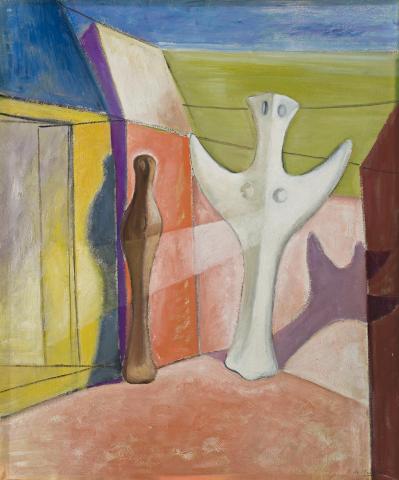ANNUNCIATION, c.1934
Roy de Maistre
oil on panel
66.5 x 55.5 cm
signed lower right: R. de Maistre
Dimitrije Mitrinovic, United Kingdom
Trustees of the New Atlantis Foundation, United Kingdom
Gladys MacDermot, London
Thence by descent
Private collection, Switzerland
Sotheby's, Melbourne, 24 November 2008, lot 74
Company collection, Victoria
The Zwemmer Gallery, London, November 1934 (label attached verso) Roy de Maistre: A Retrospective Exhibition of Paintings and Drawings 1917–1960, Whitechapel Art Gallery, London, May – June 1960, cat. 34
Johnson, H., Roy de Maistre: The English Years 1930–1968 , Craftsman House, Sydney, 1995, pp. 77, 80, 129
Roy de Maistre's move to London in mid-1930 soon found him associated with the avant-garde, holding a joint exhibition with Frances Bacon that same year. Supported by both of London's leading contemporary galleries, the Mayor and Zwemmer, he rapidly began making a name for himself. The Mayor, which was associated with such major Continental artists as Picasso, Paul Klee and Jean Miro, and the English Edward Wadsworth and Eric Gill, gave him a solo exhibition in 1934. Widely reviewed and well received, the critic for the Scotsman described his paintings as 'thoughtful essays in the Picasso- Chirico tradition, rich in colour and in their arrangement of abstract shapes often vital and exciting.'1 Annunciation, reflecting, as it does, the words of the critic, was one of the paintings in this exhibition. Acquired by the prominent writer and art collector, Dimitrije Mitrinovic, it is not known if he lent Annunciation to the exhibition or purchased it there. An influential friend, Mitrinovic owned a number of works by De Maistre. His circa 1953 portrait by De Maistre is in the collection of the Art Gallery of New South Wales. Interestingly, in 1934 De Maistre also exhibited several works at the Zwemmer Gallery, This was the same year in which the Gallery presented the important exhibition Objective Abstractionists of works by such young British artists as Graham Bell, Ivon Hitchens, Victor Pasmore and Ceri Richards. At some time the Zwemmer Gallery also handled Annunciation. De Maistre considered it to be so important a work that he included it in his 1960 retrospective exhibition held at London's Whitechapel Art Gallery.
The Annunciation is such a traditional subject in Christian art that De Maistre's painting comes as a refreshing change. Working in the spirit of the Christian Gospel, he presented the good news in contemporary terms with more than mere echoes of Henry Moore and Jean Arp in the chosen sculptural forms. The moment depicted is the Archangel Gabriel's announcement to the Virgin Mary that she will conceive and give birth to the Saviour. Mary is represented as humble of form in everyday brown, casting a shadow of blue, her traditional colour, while set against a royal red background, the liturgical colour of the Holy Spirit. De Maistre's use of the three primary colours with the transitional purple, the ancient colour royal, is but part of the brilliance of colour exploration that characterizes so much of his best art. His use of forms is equally individual. In De Maistre's hands the white figure of the Archangel undergoes a metamorphosis, being both angelic and bird-like. The arms, raised in salutation as the messenger of God, are interchangeable as the wings of the dove, the traditional symbol of the Holy Spirit. The whiteness of the emanating light symbolizes the purity of the conceiving spirit of God. While the scene is an enclosure, the earlier garden scenes now replaced by a modernistic setting in which the interaction of colour and angular lines suggest arrested movement, the paradox of energy and stillness worthy of this most celebrated occasion.
1. 'London Art Shows', Scotsman, 24 October 1934, quoted in Johnson, op. cit., p. 70
DAVID THOMAS
